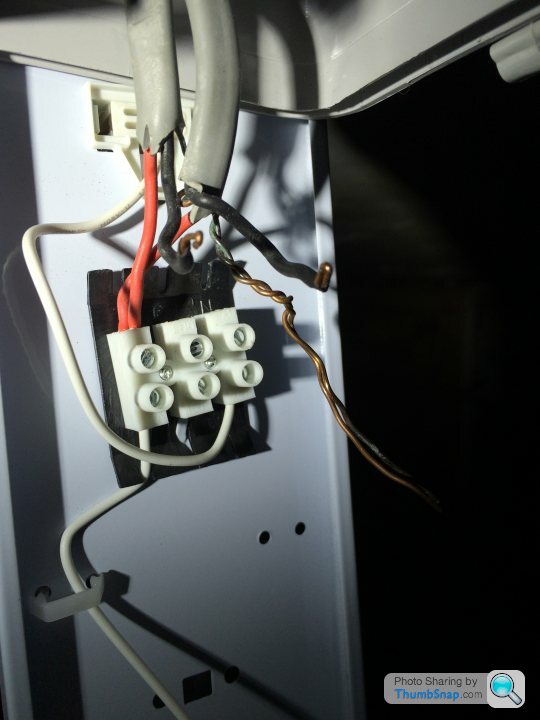Another wiring question!
Discussion
I'm in the process of replacing a ceiling batten light with an LED tube light, and things are not as straightforward as I'd predicted (to me anyway).
There's a simple setup of a switch and the light, however the switch cable hasn't been sleeved or marked, and I don't have a meter tool.
Here's what the wiring was like on the original light:

and here's where I currently am - just the two joined reds connected.

The wiring block on the new light is Live, Earth, Neutral.
How would I go about identifying the switched live black wire? Presumably that would also connect to L, and the other black to N?
Thanks in advance for help.
There's a simple setup of a switch and the light, however the switch cable hasn't been sleeved or marked, and I don't have a meter tool.
Here's what the wiring was like on the original light:

and here's where I currently am - just the two joined reds connected.

The wiring block on the new light is Live, Earth, Neutral.
How would I go about identifying the switched live black wire? Presumably that would also connect to L, and the other black to N?
Thanks in advance for help.
Right. Connect the two reds together in a piece of connector strip. If you have a test meter or multimeter that reads ac volts, turn the power back on and carefully with one probe in the connector strip containing the two reds use the other probe on one black after another. One will give a reading o 230- 240 volts. That one will be the neutral the other black will be the switch wire. That's live when the switch is on. So don't touch anything accidentally. Shouldn't need to say don't touch this unless you're 100% confident.
Disconnect both cables (having turned the power off first of course). Connect a continuity tester across red and black on one of the cables. Flick the switch on - if it beeps / displays a low resistance reading, that is your switch wire. If not, try the other. This method does not mean working on live conductors, like the previous suggestion.
Once you have established which is the switch wire, mark the black as a live conductor with red tape or sleeving.
Wire the two reds together in a connector. Connect the black to the neutral terminal on the light fitting and the black you have just marked with red tape / sleeving into the live. Untwist those earths and fit some yellow / green sleeving and connect them to the earth terminal.
Once you have established which is the switch wire, mark the black as a live conductor with red tape or sleeving.
Wire the two reds together in a connector. Connect the black to the neutral terminal on the light fitting and the black you have just marked with red tape / sleeving into the live. Untwist those earths and fit some yellow / green sleeving and connect them to the earth terminal.
Edited by Ganglandboss on Friday 28th August 21:03
gazzarose said:
If you've got a spare pendant light fitting hanging about you can use it as a test lamp. I you connect one wire to the red wires, and then the other wire to eash of the black wires in turn, which ever black wire makes the light come on is the neutral.
you can buy a multi-meter from Screwfix for a tenner, and not prat about connecting junk to live conductors and killing yourself.Ganglandboss said:
you can buy a multi-meter from Screwfix for a tenner, and not prat about connecting junk to live conductors and killing yourself.
The older (and admittedly richer) I get and the more dependents I have the less inclined I am to piss about with my own wiring. Certainly wouldn't ever mess about without a multi-meter. Gassing Station | Homes, Gardens and DIY | Top of Page | What's New | My Stuff



